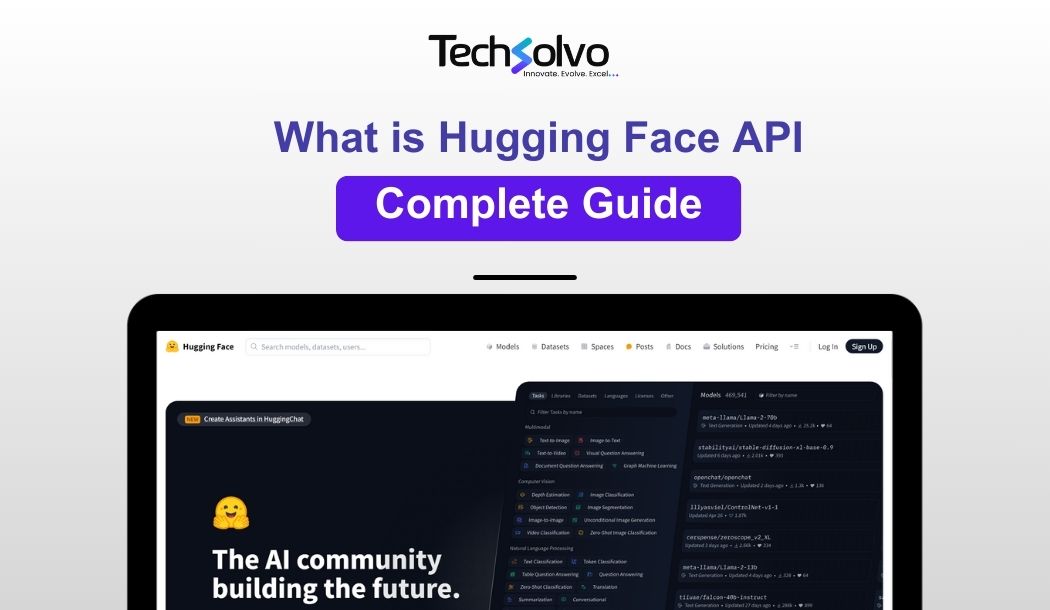
Introduction to Hugging Face API
The Hugging Face API stands at the forefront of the natural language processing (NLP) revolution, offering developers a powerful toolkit to leverage cutting-edge NLP models and techniques. Essentially, it provides a centralized platform for accessing, fine-tuning, and deploying state-of-the-art NLP models, empowering developers to create smarter and more efficient applications.
At its core, the Hugging Face API democratizes access to advanced NLP capabilities, making it accessible to both seasoned developers and newcomers alike. Through its intuitive interface and comprehensive documentation, developers can seamlessly integrate powerful NLP functionalities into their projects with minimal effort.
What truly sets the Hugging Face API apart is its vast repository of pre-trained models, ranging from transformers like BERT and GPT to specialized models tailored for specific tasks such as sentiment analysis, text summarization, and language translation. These pre-trained models serve as a solid foundation, allowing developers to quickly prototype and deploy NLP applications without the need for extensive training data or computational resources.
Moreover, the Hugging Face API facilitates fine-tuning of these pre-trained models on custom datasets, enabling developers to adapt them to specific domains or use cases. This level of customization empowers organizations to build highly accurate and contextually relevant NLP solutions that meet their unique requirements.
In essence, the Hugging Face API is revolutionizing NLP tasks by democratizing access to advanced models, simplifying their integration into applications, and fostering innovation in the field of natural language processing. Whether it's sentiment analysis for customer feedback, chatbots for personalized interactions, or language translation for global communication, the Hugging Face API equips developers with the tools they need to push the boundaries of what's possible with NLP.
Easy Integration
Integrating the Hugging Face API into your existing projects or applications is a breeze, thanks to its developer-friendly design, comprehensive documentation, and availability of software development kits (SDKs). Here's how the Hugging Face API streamlines the integration process:
-
SDKs and Libraries: The Hugging Face API provides SDKs and libraries for popular programming languages such as Python, JavaScript, and Java, among others. These SDKs abstract away the complexities of HTTP requests and authentication, allowing developers to interact with the API using familiar programming paradigms and idioms.
-
Comprehensive Documentation: The Hugging Face API boasts extensive documentation that covers every aspect of its functionality, from getting started guides to advanced usage scenarios. Whether you're a seasoned developer or a newcomer to NLP, the documentation provides clear and concise instructions for integrating the API into your projects.
-
Quickstart Guides: To expedite the integration process, the Hugging Face API offers quickstart guides and tutorials that walk you through the setup and usage of its core features. These guides provide step-by-step instructions, code samples, and best practices to help you hit the ground running.
-
Code Examples and Templates: Additionally, the Hugging Face API provides a wealth of code examples and templates that demonstrate common use cases and implementation patterns. These resources serve as valuable references and inspiration for developers looking to leverage the API in their projects.
-
Interactive Playground: For experimentation and testing purposes, the Hugging Face API offers an interactive playground where developers can explore its capabilities in a sandbox environment. This allows you to interactively query models, inspect responses, and fine-tune parameters before integrating them into your applications.
Overall, the Hugging Face API prioritizes ease of integration, offering a seamless experience for developers looking to harness the power of state-of-the-art NLP models. Whether you're building a new application from scratch or enhancing an existing project with NLP capabilities, the Hugging Face API provides the tools and resources you need to succeed.
State-of-the-Art Models
The Hugging Face API offers a diverse range of state-of-the-art NLP models, including popular architectures such as BERT, GPT, and RoBERTa, among others. These models represent the cutting edge of natural language processing research and are renowned for their exceptional performance across a wide range of tasks. Let's explore how these models can be utilized for various NLP tasks:
-
BERT (Bidirectional Encoder Representations from Transformers):
- BERT is a transformer-based model developed by Google that has achieved remarkable results in tasks such as text classification, question answering, and named entity recognition.
- With its bidirectional approach to language representation learning, BERT is adept at capturing contextual information from both preceding and succeeding words in a sentence.
- BERT's versatility makes it well-suited for tasks such as sentiment analysis, where understanding the context of a sentence is crucial for determining sentiment polarity.
-
GPT (Generative Pre-trained Transformer):
- GPT, developed by OpenAI, is a class of transformer-based language models known for their ability to generate coherent and contextually relevant text.
- GPT models excel in tasks such as text generation, language translation, and dialogue generation, where generating human-like responses is paramount.
- By leveraging the context provided by preceding words, GPT models are capable of generating text that is grammatically correct and semantically coherent.
-
RoBERTa (Robustly optimized BERT approach):
- RoBERTa is an optimized version of BERT developed by Facebook AI, designed to improve upon BERT's performance by fine-tuning various hyperparameters and training regimes.
- RoBERTa achieves state-of-the-art results across a range of NLP benchmarks, including tasks such as text classification, question answering, and textual entailment.
- With its robust architecture and extensive pre-training on large text corpora, RoBERTa is particularly effective for tasks requiring nuanced understanding of language semantics and syntax.
These state-of-the-art models offered by the Hugging Face API can be seamlessly integrated into various NLP applications to address a multitude of tasks:
- Text Classification: Classify text documents into predefined categories or labels, such as sentiment analysis, topic classification, or spam detection.
- Sentiment Analysis: Determine the sentiment or emotional tone conveyed by a piece of text, such as positive, negative, or neutral sentiment.
- Text Generation: Generate human-like text responses or continuations based on input prompts, facilitating applications such as chatbots, dialogue systems, and content generation.
By leveraging these powerful models available through the Hugging Face API, developers can unlock new possibilities in natural language understanding and generation, revolutionizing how we interact with and process textual data.
Customization Options
The Hugging Face API offers developers a high degree of flexibility and customization options, empowering them to tailor pre-trained models to specific tasks or even train their own models from scratch. Let's explore the customization options provided by the Hugging Face API:
-
Fine-Tuning Pre-trained Models:
- One of the key features of the Hugging Face API is the ability to fine-tune pre-trained models on custom datasets. This process involves adjusting the parameters of a pre-trained model to better suit the nuances of a specific task or domain.
- Developers can fine-tune models such as BERT, GPT, or RoBERTa by providing annotated training data and fine-tuning hyperparameters. This allows them to adapt the model's learned representations to the specific characteristics of their target task, such as sentiment analysis or named entity recognition.
- Fine-tuning pre-trained models enables developers to achieve state-of-the-art performance on task-specific benchmarks with relatively small amounts of labeled data.
-
Custom Training:
- In addition to fine-tuning pre-trained models, developers can also train their own models from scratch using the Hugging Face API. This process involves defining the architecture of the model, specifying training objectives, and providing training data.
- By training custom models on proprietary or domain-specific datasets, developers can create tailored solutions that address the unique requirements of their applications. This flexibility is particularly beneficial for industries or use cases with specialized language patterns or terminology.
-
Model Composition and Pipelines:
- The Hugging Face API provides a wide range of pre-built model compositions and pipelines that simplify the development process for common NLP tasks. These pre-configured pipelines encapsulate complex model architectures and processing steps, allowing developers to quickly deploy end-to-end solutions without the need for extensive coding.
- Developers can customize pipelines by selecting specific models, tokenizers, and post-processing steps to suit their requirements. This modular approach enables rapid prototyping and experimentation while maintaining flexibility and control over the underlying components.
-
Model Sharing and Collaboration:
- The Hugging Face API fosters a collaborative ecosystem where developers can share, discover, and remix models created by the community. This includes both pre-trained models and fine-tuned variants tailored for specific tasks or domains.
- By leveraging shared models and contributions from the community, developers can accelerate development cycles, benefit from collective expertise, and access a diverse range of models optimized for various use cases.
Overall, the customization options offered by the Hugging Face API empower developers to create tailored NLP solutions that meet the specific needs of their applications. Whether fine-tuning pre-trained models, training custom architectures, or leveraging pre-built pipelines, developers have the flexibility and tools they need to innovate and push the boundaries of natural language processing.
Scalability and Performance
The Hugging Face API offers unparalleled scalability and performance benefits, making it an ideal choice for handling large volumes of text data and real-time processing requirements. Here's how the Hugging Face API excels in terms of scalability and performance:
-
Cloud-Based Infrastructure:
- The Hugging Face API is hosted on robust cloud infrastructure, allowing it to effortlessly scale to accommodate varying workloads and demand spikes. Whether you're processing a few requests or millions, the API dynamically allocates resources to ensure smooth and efficient operation.
-
Distributed Processing:
- Leveraging distributed computing techniques, the Hugging Face API distributes computational tasks across multiple nodes or instances, enabling parallel processing of large datasets and complex computations. This distributed architecture ensures optimal resource utilization and minimizes processing times, even for demanding workloads.
-
GPU Acceleration:
- The Hugging Face API harnesses the power of GPU acceleration to accelerate model inference and training, particularly for deep learning models such as transformers. GPUs excel at performing matrix operations and neural network computations in parallel, significantly speeding up processing times for NLP tasks.
-
Asynchronous Processing:
- To handle real-time processing requirements and high concurrency scenarios, the Hugging Face API supports asynchronous request handling. This allows multiple requests to be processed concurrently without blocking the main execution thread, resulting in faster response times and improved overall system performance.
-
Caching and Optimization:
- The Hugging Face API employs caching mechanisms and optimization techniques to minimize redundant computations and maximize resource efficiency. By caching frequently accessed data and intermediate results, the API reduces latency and accelerates subsequent requests, enhancing overall responsiveness and scalability.
-
Auto-Scaling and Elasticity:
- With auto-scaling capabilities built into its infrastructure, the Hugging Face API automatically adjusts resource allocation based on workload fluctuations and demand patterns. This elasticity ensures that resources are allocated optimally to meet current requirements, while also minimizing operational costs during periods of low activity.
-
Service Level Agreements (SLAs):
- The Hugging Face API offers robust service level agreements (SLAs) guaranteeing uptime, availability, and performance metrics. These SLAs provide assurance to developers and businesses regarding the reliability and scalability of the API, allowing them to confidently deploy mission-critical applications and services.
In summary, the Hugging Face API's scalability and performance capabilities enable developers to effortlessly handle large volumes of text data, process requests in real-time, and deliver responsive and reliable NLP applications. Whether you're building chatbots, analyzing social media streams, or processing documents at scale, the Hugging Face API provides the scalability and performance you need to succeed.
Community and Support
The Hugging Face ecosystem thrives on a vibrant and engaged community of developers, researchers, and NLP enthusiasts, offering a wealth of resources, support, and collaboration opportunities. Here's how the community surrounding the Hugging Face API contributes to its success:
-
Forums and Discussion Boards:
- Hugging Face provides online forums and discussion boards where developers can seek help, share insights, and collaborate with peers. These forums serve as valuable platforms for asking questions, troubleshooting issues, and exchanging ideas related to NLP and the Hugging Face API.
-
Tutorials and Guides:
- The Hugging Face community actively produces tutorials, guides, and educational resources to help developers learn and master the use of the API. These resources cover a wide range of topics, from getting started with the API to advanced techniques for model fine-tuning and deployment.
-
Community-Contributed Models:
- One of the hallmarks of the Hugging Face ecosystem is its extensive repository of community-contributed models and resources. Developers can discover, fork, and remix pre-trained models shared by the community, accelerating development cycles and fostering innovation in NLP.
-
Hackathons and Events:
- Hugging Face regularly organizes hackathons, workshops, and events that bring together members of the community to collaborate on NLP projects, share ideas, and showcase their work. These events provide opportunities for networking, learning, and hands-on experimentation with the Hugging Face API.
-
Support Resources:
- Hugging Face offers comprehensive support resources, including documentation, FAQs, and dedicated support channels, to assist developers using their API. Whether you encounter technical issues, need guidance on best practices, or have questions about specific features, the support team is readily available to help.
The collaborative spirit and shared enthusiasm within the Hugging Face community contribute to the ongoing success and innovation of the Hugging Face ecosystem, making it a welcoming and inclusive environment for developers of all skill levels.
Use Cases
TechSolvo and numerous other companies have successfully leveraged the Hugging Face API to address a wide range of real-world problems across various industries. Here are a few examples of how companies have utilized the API to drive innovation and solve practical challenges:
-
Customer Support Chatbots:
- Companies like TechSolvo have deployed chatbots powered by the Hugging Face API to enhance customer support experiences. These chatbots can intelligently respond to customer inquiries, provide relevant information, and escalate complex issues to human agents when necessary, improving response times and customer satisfaction.
-
Content Moderation:
- Social media platforms and online communities use the Hugging Face API to perform content moderation tasks such as detecting hate speech, offensive language, and inappropriate content. By leveraging advanced NLP models, these platforms can automatically filter and flag problematic content, ensuring a safer and more inclusive online environment.
-
Text Analytics and Insights:
- Companies leverage the Hugging Face API to analyze large volumes of text data, extract meaningful insights, and derive actionable intelligence. This includes sentiment analysis, topic modeling, and entity recognition, enabling businesses to gain valuable insights into customer feedback, market trends, and competitor activities.
-
Language Translation and Localization:
- Multinational companies utilize the Hugging Face API for language translation and localization efforts, enabling them to communicate effectively with global audiences. By leveraging pre-trained models and fine-tuning them on domain-specific data, companies can achieve accurate and contextually relevant translations tailored to their target markets.
These examples demonstrate the versatility and effectiveness of the Hugging Face API in solving real-world problems across diverse industries and use cases. By harnessing the power of advanced NLP models and community-driven innovation, companies can drive digital transformation, enhance customer experiences, and unlock new opportunities for growth and innovation.
Cost and Pricing:
The Hugging Face API offers a flexible and transparent pricing model that aligns with the needs and budget constraints of companies like TechSolvo. While specific pricing details may vary based on usage levels and features, the API typically operates on a pay-as-you-go model, where users are charged based on their usage of computational resources and services.
This model allows companies to scale their usage of the Hugging Face API according to their needs, paying only for the resources they consume. Additionally, the API often provides free tiers or trial periods, allowing developers to explore its capabilities and evaluate its suitability for their projects before committing to a paid plan.
By leveraging the cost-effective pricing options offered by the Hugging Face API, companies can effectively manage their budgetary considerations while accessing powerful NLP capabilities to drive innovation and achieve their business objectives.
Security and Compliance
Security and data privacy are paramount considerations when using any third-party API, including the Hugging Face API. Hugging Face prioritizes the protection of user data and compliance with relevant regulations and standards, implementing robust security measures and safeguards to ensure the confidentiality, integrity, and availability of data.
Some of the key security features and measures implemented by Hugging Face include:
-
Encryption: All data transmitted between client applications and the Hugging Face API is encrypted using industry-standard protocols such as HTTPS, ensuring secure communication and data transfer.
-
Access Control: Hugging Face employs access control mechanisms to restrict access to sensitive resources and functionalities, ensuring that only authorized users and applications can interact with the API.
-
Data Privacy: Hugging Face adheres to stringent data privacy practices and regulations, including GDPR compliance, to safeguard user privacy and protect personal information from unauthorized access or misuse.
-
Auditing and Monitoring: Hugging Face continuously monitors and audits its infrastructure and systems to detect and mitigate security threats and vulnerabilities proactively. This includes real-time monitoring of network traffic, system logs, and user activity to identify and respond to potential security incidents.
Conclusion
In conclusion, the Hugging Face API offers a compelling solution for companies like TechSolvo seeking to harness the power of natural language processing in their projects or applications. With its ease of integration, powerful capabilities, and extensive community support, the Hugging Face API empowers developers to build intelligent and innovative NLP solutions that drive value and differentiation.
By leveraging state-of-the-art models, flexible customization options, and scalable infrastructure, companies can address a wide range of use cases, from customer support chatbots to content moderation and text analytics. The transparent pricing model and robust security measures provided by Hugging Face ensure that companies can effectively manage costs and mitigate security risks while unlocking the full potential of the API.
Overall, the Hugging Face API represents a valuable asset for companies looking to stay ahead in the rapidly evolving landscape of natural language processing, enabling them to deliver cutting-edge solutions that enhance user experiences, drive operational efficiency, and fuel growth and innovation.
Insights
To properly understand the things that are prevalent in the industries, keeping up-to-date with the news is crucial. Take a look at some of our expertly created blogs, based on full-scale research and statistics on current market conditions.

Why ERPNext is the Best ERP Software for Businesses in 2025 | Techsolvo
Discover why ERPNext is the top choice for modern businesses in 2025. Learn how Techsolvo…

Why Techsolvo is the Best ERPNext Implementation Partner in UAE
Discover why Techsolvo is recognized as the best ERPNext agency in the UAE. Trusted by ma…

How We Self-Hosted ERPNext with Cloudflare Tunnel and Fixed Static Asset Issues
Learn how Techsolvo successfully deployed a self-hosted ERPNext instance using Cloudflare…

